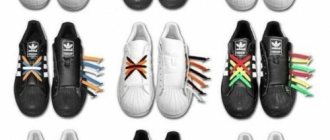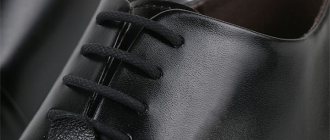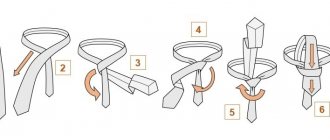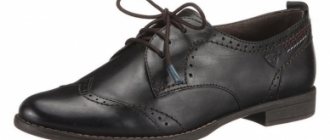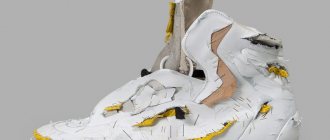Modern shoe models are often equipped with laces. These products are designed for comfortable, safe use of shoes or sneakers, taking into account the anatomical features of the foot. For comfortable wear, it is important to know how to tie the laces so that they do not come undone while moving. Thanks to a variety of lacing methods and options, the shoes not only fit perfectly on the foot, making movements comfortable, but also acquire a stylish, original appearance, looking different in each new look.
Methods for tying shoelaces
Previously, people only thought about the practicality of the knot, but for modern fashionistas reliability is not enough; they want their shoes to look stylish and attractive. So, sneakers were originally created for sports, but over time they became a part of our wardrobe and became an everyday part of a beautiful look.
Now they are worn with dresses, skirts, skinny jeans and even office suits, but to make it look harmonious, fashionistas began to think about quick ways to tie shoelaces. Australian Ian Figen played a significant role in this, he came up with most of the knots and shared them on his personal website. Here are some of them:
- hidden node;
- tangled trail;
- Sherpa knot;
- criss-cross;
- straight lacing;
- web;
- Chess board.
All methods look beautiful and unusual and attract attention to your sneakers.
One of the varieties of the cross method
The main difference between this option and the one discussed earlier is that the laces are inserted into the holes from top to bottom, crossed from the inside, after which they are brought out again and crossed again. The main advantage of this method is the high lacing speed. Other advantages of the method are ease of lacing and reduced wear. It only fits sneakers with a pair of holes. Otherwise, the upper ends of the laces will be directed into the inside of the shoe, which will cause some inconvenience during tying.
How to tie laces on sneakers so they don't come undone
During running or intensive walking, the tape should not come undone or rub the foot, so you should use the classic and quick method for sports sneakers.
Once you have completed the cross lacing, make a loose knot near the last hole. Tie a kind of bow and hide the laces in your sneakers.
For Sport
- Start with the bottom section and thread the edges through the armholes.
- Push the left edge straight and up, and then pull it into the adjacent eyelet, entering it from below.
- Skip one hole and thread the ribbon through the top.
- Do the same with the left edge.
- Continue alternately until you reach the top loop.
The method is suitable for even pairs of holes and prevents snags while climbing mountains or through bushes.
For beauty
If ordinary knots no longer seem difficult to you, then you can go to an advanced level and master the “checkerboard” method, for which you will need 2 colors of long braid.
First make straight lacing in one color, and then wavy in another shade. Then wrap the first with the second lace and continue the vertical tie as long as the length of the product allows. True, this method of tying a braid, although beautiful, is not very practical, since it forms a weak fastener.
Methods for securing nodes
Untied shoelaces can be quickly and easily secured. Reliable methods are convenient and beautiful in execution.
| Tying method | Algorithm of actions |
| Double knot |
|
| Figure eight knot |
|
| Jan Figgen's knot - named after the author, distinguished by reliability, beauty, and convenience |
|
| "Mega Knot" is the most reliable option |
|
| Double sliding knot - self-tightening element, characterized by a high degree of reliability |
|
| Surgical knot - considered the safest type |
|
To prevent the lace from coming undone, it is necessary to firmly fix the knots. Using the proposed methods you can lace sneakers, classic boots, derbies, and boat shoes.
Laces are designed to securely secure shoes on your feet when walking or running. The tightness of the fit, which ensures safety during movement, depends on the method of tying the ribbons and securing the knot. The original lacing is suitable for classic, sports and casual shoe models.
Double knot
Figure eight knot
Jan Figgen Knot
"Mega Knot"
Double slip knot
Surgical knot
How to tie long laces on sneakers so they don't dangle
Most often they dangle due to excessive length, but this problem can be easily solved if you know how to properly tie the laces on sneakers.
- Insert them from above into the lower ears.
- Pull the left side out from the very top gap and adjust the laces to the required length.
- Pull the right end through the penultimate eye and pull it through so that it comes out on the left side through the second hole from the bottom.
- Pull it through the top again and continue to spiral up, left, down and right.
For athletes, it is very important to tie long laces correctly so that they do not dangle, so the above method is not the only one.
- Pull the two ends of the braid out and twist them together once.
- Move them in different directions and pass them under the loophole.
- Repeat the procedure until you run out of ears.
- Tie a bow to secure the lacing.
An additional knot on sneakers or sneakers shortens long ropes and increases the strength of the tie, so it is suitable for ski boots.
Useful tips
If there is no particular desire to learn new methods of fixing knots, then you can use the recommendations for improving the standard ones. In addition, designers and manufacturers are inventing new options. For example, there are now easy-to-use silicone laces.
In order for the standard unit to be more reliable and stronger, it should be slightly modified, or rather, supplemented. Two loops are formed. One goes around the other, creating a knot. Then the whole process is repeated, one loop going around the other again. The result is a so-called double knot or bow. The method is so simple that even a child who has just learned to lace shoes can master it.
If ordinary laces cannot be firmly fixed and the knots constantly unravel, then you can use silicone analogues. Their appearance is quite original. Not only the shape is impressive, but also the bright colors. For each pair of holes on the shoe there is a separate lace, which is more like a bracelet with a lock. Each copy is threaded through two holes located on the same horizontal line, the ends are connected and secured with a special fastener. This option is very simple to implement and quite reliable. A noteworthy fact is that you can use different colors of the product for each pair of holes.
Another option for a modified standard knot is Quick Lace. This system is especially popular in professional sports. Its peculiarity is the use of a plastic retainer into which fairly thin laces are threaded. The mechanism is tightened to the required length. The ends of the laces, together with the lock, are hidden in a specially equipped pocket on the tongue of the shoe. If there is none, then you can hide the freely hanging ends under the tongue, they will not stick out and get in the way.
All the variety of devices for lacing shoes is designed for greater convenience. Everyone can choose the most acceptable option suitable for a particular case. However, sometimes you can experiment by creating fancy knots or a rainbow of silicone laces.
If you don’t want to constantly tie your shoelaces, you can choose their silicone counterparts
How to tie shoelaces beautifully
Hidden lacing looks beautiful on sneakers and trainers.
- First, thread them through the holes at the top.
- Pull the left side up, and then across and out.
- Repeat these movements alternately on each side, but do not forget to skip one ear.
- When the ends meet, tie them and tuck them into your sneakers.
The "spider web" method
The lace should be pulled through the lower holes, crossed and threaded through the fourth pair of holes. After this, both ends are raised up a couple of ears and brought out. All that remains is to cross them, repeat all the steps again and tie a bow.
How to properly lace running shoes
How tight should you tighten your laces, and how can you check that you've done everything correctly? If you do not want to injure your foot, pay attention to proper lacing on your shoes.
Rule 1
The laces need to be tightened so that the foot does not “dangle”, but also not too tight, since in shoes that are too tight, blood will flow poorly to the feet.
Rule 2
To avoid overdoing the lacing, curl your toes inward in your sneakers: your foot will rise slightly, and this will allow you to leave room for its movement during push-off.
Rule 3
Please ensure that the degree of tightening is the same throughout the entire length. Don't forget to unlace your sneakers before taking them off. This will extend the life of your running shoes.
Rule 4
Probably, few people have thought about the fact that not only sneakers are selected based on the type of workout ahead, but also the lacing of the shoes. So, if you're going to do an intense workout, lock your feet tightly to ensure efficient and safe movement. If you're planning a recovery run, rest your feet and lace your shoes looser.
marathon and half marathon training plans and start training today!
The correct shoe tie
For boots, traditional criss-cross lacing is suitable. Exit through the bottom holes and cross the ends, bringing them under the sides of the boots.
But for military boots, a completely different scheme is used, thanks to which they do not come untied. Tie a knot at one end and only then start tying the laces. To do this correctly, pull the product all the way and check that it is securely fastened. Bring the loose end out and then through the adjacent loop and repeat until you run out of length.
Types and patterns of lacing
Are you used to regular bows? Or maybe you want to learn how to tie them too? We will look at both the classic pattern and original lacing methods that will make your look unique.
Standard scheme
This type is standard and familiar to almost all owners of sports shoes. First, tie it into a light knot, then fold both laces in half and make a knot from the resulting “ears.” Tighten it tight: it's done.
There is also a similar method, but in it we start tying by folding only one lace in half.
For parents : if you want to teach your children how to tie their shoelaces using this pattern, make a pattern out of cardboard or use a ready-made toy trainer.
How to tie shoelaces
Every man must know how to tie his office shoes beautifully so that they do not come undone. The main problem is that they are much longer than necessary and often dangle underfoot. To avoid this, lace your shoes correctly. The laces will become shorter if you first thread them horizontally and then vertically. This way they will look beautiful and will not come undone.
A method to hide laces in sneakers
A method that allows you to hide the knot during lacing makes it possible to neatly lace your sneakers. In this case, the ends of the lace should be hidden inside the shoes. This is the most effective option, which has no disadvantages for shoes that have a pair of holes. Despite this, some difficulties may arise when tying your shoelaces. In addition, the compaction that appears after tying brings some discomfort while wearing shoes.
As for the lacing procedure, it has some common features with the rectangular method. There is one significant difference - one end must be made shorter than the other. After finishing the lacing procedure, both parts of the lace are hidden inside the sneaker. The main feature of the method is that the left side is left unlaced, while the right side is laced completely. The last step of lacing with this method is to tie both parts of the accessory on the left side of the shoe.
How to tie a bow correctly
The knot to which the laces are tied also plays an important role. Tying a classic bow is very simple, but it is not very reliable, so it is better to use more sophisticated methods.
For example, the “surgeon’s” knot does not untie throughout the day.
A sliding bow is also not easy to do, but laces tied in this way never dangle.
Now you know how to beautifully tie laces on sneakers, sneakers, boots and shoes. All that remains is to pick up the shoes and start mastering the methods you like.
Main features of laces for sports shoes
At first glance, it seems that laces are not the most important component of any shoe. However, without this detail it is impossible to wear your favorite sneakers. This accessory appeared at the beginning of the twentieth century, which greatly simplified the wearing of shoes. Previously, instead of this part, special fasteners were used - buttons, buckles.
Laces are pieces of thin rope of a certain length that are threaded through holes in the shoe and are designed to hold it on the foot. Accessories are made from artificial and natural materials. They have tips made of plastic, silicone and metal, which are located at the ends of the laces. This greatly simplifies the lacing process and also prevents the product from fraying.
Products in topic
- -20 % Sneakers Converse Chuck Taylor All Star Lo black M9166 RUR 5,040 Old price: 6,300 rub. Available sizes: 8.5, 9, 10, 23.5, 28, 37.5, 44.5
- -20 % Sneakers Converse Chuck Taylor All Star Lo white M7652 RUR 5,040 Old price: 6,300 rub. Available sizes: 4, 6.5, 23.5, 24.5, 37.5
- -20 % Sneakers Converse Chuck Taylor All Star Lo M9697 navy 5,040 rub. Old price: 6,300 rub. Available sizes: 4.5, 5, 5.5, 6.5, 7, 7.5, 8, 9.5, 11, 22, 22.5, 24.5, 27, 30.5, 36.5, 42.5, 44, 44.5, 47
Roman version
This method has an aesthetic appearance, but there may be some difficulties when tightening the laces.
The lacing procedure has the following sequence:
- one lace is pulled through the left hole of the sneaker, after which it rises vertically and comes out of the hole;
- the upper end of the accessory is inserted into the lower hole on the right side, and the lower end at this moment into the upper one;
- after this, the lower part of the lace should be pulled up two holes, and then to the opposite side, again up one level;
- the other end is pulled up two levels at once, while allowing one hole to pass through;
- then the ends that have been crossed rise one level higher and are tied into a small knot.
Multi-colored cross lacing
Simple, bright and effective lacing. And most importantly, you choose the color combination!
Instructions:
- Pull one of the laces through the first holes and cross its ends.
- Thread through the third holes.
- Draw a lace of a different color, matching the first one, in the same way, but threading it through the first holes and pulling it out into the fourth holes.
- Lace the shoes in the same way until the end.
- Tie a knot or bow from the inside.
To get an even more unusual result, use contrasting laces.
"Web"
Recently, this method has been gaining popularity.
Lacing technique:
- Pull the tip of the lace into the second hole from the inside.
- Pass from the outside and through the first holes.
- Make the laces crosswise and pull them from the inside through the third holes.
- The ends must be pulled out under the upper holes and inserted from the inside into the fourth holes.
- Finally, thread the aiglets under the second holes and pull them from the inside into the fifth holes from the outside.
- The knot is hidden behind the tongue.
Eglet is the metal end of a cord.
Method called "Butterfly"
Many people are interested in the answer to this question: are there ways to lace sports shoes if the ties are not long enough? The answer is simple - there is such a method, and it’s called “Butterfly”. This option is characterized by an unusual appearance.
The lacing procedure consists of the following steps:
- the lace is passed inside;
- then it is pulled vertically, after which the string is pulled out;
- after crossing, the ends are pulled into the next pair of holes;
- the completed actions are repeated again to the top.
If there is an odd number of holes, the lacing procedure is completed by crossing the laces; if there is an even number, the lacing comes out without crossing.
Lacing method "Ladder"
This option is preferable for those who want to lace their sneakers in an unusual way. You should immediately note that the chosen method is difficult to implement. In addition, it will be extremely difficult to tighten the laces more tightly. Despite the difficulties, this option looks very impressive. The method is suitable for tall shoes or sneakers with long laces.
The sequence of actions is as follows:
- the laces extend from the inside to the outside;
- their ends are lifted and passed into the holes that are located at the top;
- then they need to be crossed among themselves and threaded under the vertical sections;
- then they lift it one step up, pass it through the holes, and then cross it again;
- manipulations are repeated until lacing is completed.

